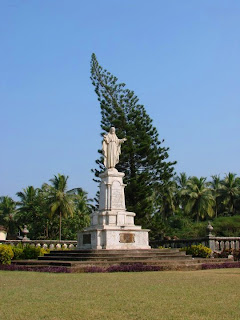Basilica of Bom Jesus is one of the finest examples of Baroque architecture in old Goa.
A 17th century church (consecrated in 1605 by the Archbishop Dom Father Alexio Menezes, after eleven years of tireless construction), it is today a UNESCO World Heritage Site.
Its main point of distinction is also the fact that it holds the mummified mortal remains of St Francis Xaviers, a priest from Spain who did major part of his missionary work in Goa.
Besides the main altar which is spectacular to say the least, there lies the masauleum of St Francis Xaviers with his remains protected in a silver casket which was apparently gifted by the last of the Medicis, Cosimo III, the Grand Duke of Tuscany. The mausoleum was designed by the seventeenth Florentine sculptor Giovanni Batista Foggini .The walls are elaborated with paintings depicting the life of the saint.
The upper floor holds a museum displaying missionary art.and paintings by Dom Martin.
The Se Cathedral is located right opposite the Basilca church and is separated by a tar road connecting Panaji with old Goa.
The cathedral is dedicated to Catherine of Alexandria. It is also the cathedral of Latin Rite Catholic Archdiocese of Goa and Daman and the seat of the Patriarch of East Indies.
The Se Cathedral was built in 1619 (and consecrated in 1640) to commemorate the victory of Alfonso de Alburqueque over the Bijapur army.
The architecture is Portuguese Manueline (exterior is Tuscan and interior is Corinthian)
It is said that the cathedral had two towers out of which one collapsed and was never rebuilt. The tower holds the largest bell in Goa called the Golden bell.
The main altar is dedicated to Catherine of Alexandria and is beautified by several smaller altars and paintings depicting the life of Catherine of Alexandria. On the right is the Chapel of the cross of miracles.
Se Cathedral is said to be one of the largest churches in Asia.
Text by Abhijit Rajadhyaksha. Photographs by Sachin Dinde.



















































